

Hungry bin. A continuous flow worm farm. Why Am I Raising 4 Different Kinds Of Composting Worms? Well Let Me Tell You Why! Simple & Effective Worm Composting on your Homestead with Marjory Wildcraft. Why Compost? The benefits of composting. Compost is a soil-like mixture that consists largely of decayed organic matter and is used for fertilizing and conditioning land.
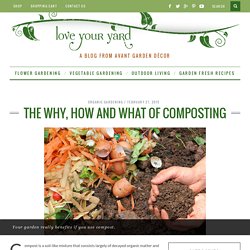
Home composting reduces the need for water, fertilizers, and pesticides and encourages a higher yield in crops. It also reduces the amount of waste products you discard. Consisting of nutrient-rich brown and green material, compost creation takes little effort and can be done by just one household or on larger scales. Creating your own compost will save you money and is easy to do! With compost starters like Ringer® Compost Plus available to help organically speed up the process, you can start reaping the benefits of your own compost in no time.
Raising Crickets For Fishing - A Favorite Food Choice for Panfish. Quite possibly a favorite food for bluegill and all other panfish is the cricket.

Fortunately they are extremely easy to raise and very easy to keep alive. Unless you are flyfishing, casting lures or noodling for catfish, you will need some bait. You could try earthworms or you could use crickets, both of which can be purchased from your local tackle and bait shop. However, if you are hardcore about your favorite past time or just a cheap person in general, then it may be worth the gratification of raising your own crickets. Secrets to Great Soil by Elizabeth Stell. Urban Worm Girl, L3C - Worms ate my garbage! Begin your adventures in worm composting. Adventures in Biochar. Bokashi Composting: Scraps to Soil in Weeks - Adam Footer. Mesophyllic fertilizer soil culturing alfalfa meal. By Kevin Meehan, owner Turtle Run Farm and Carolina Farm Stewardship Association member Every year, all the local organic farmers meet for the split up of the feather meal truck in Pittsboro, NC, go home and dump the stuff on our fields.
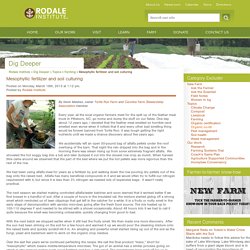
Alfalfa Meal for composting heat. Alfalfa Meal 3-1-2 Alfalfa Meal is an all natural fertilizer made from fermented alfalfa plants.
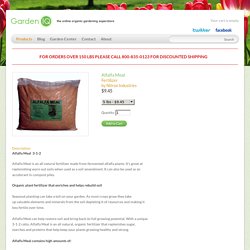
It’s great at replenishing worn out soils when used as a soil amendment. It can also be used as an accelerant in compost piles. Organic plant fertilizer that enriches and helps rebuild soil. Floating GrowOnUs water-filtering garden pops up on the Gowanus Canal. Made possible through a $20,000 grant from the Cornelia & Michael Bessie Foundation, GrowOnUs is the latest manifestation in Balmori’s series of water-purifying infrastructures throughout the city.

The firm is also interested in seeing how the filter-like gardens can generate income by producing edible plants. “We have pioneered floating landscapes, we now want to learn what can make these floating structures financially sustainable,” said Balmori Associates founder Diane Balmori. “Dr. Michael Balick at the New York Botanical Garden suggested we grow herbs, low maintenance crops that can give a financial return given their price per volume. In a few years NYC restaurants may be serving meals and drinks infused with herbs grown on one of these islands.” When we visited this morning, a pair of butterflies had already fluttered over to the landscape to check it out. L'Uritonnoir: the straw bale urinal that makes compost from 'liquid gold' "Are you used to going for a number one in the back of your garden?

" asks French design studio Faltazi. "Do not waste this valuable golden fluid by sprinkling on inappropriate surfaces! " Their solution to the problem of peeing al fresco is l'Uritonnoir, a hybrid of a urinal ("urinoir" in French) and a funnel ("entonnoir") that plugs into a straw bale to make your very own urine upcycling factory. As the bale is filled with your "liquid gold", the nitrogen in the urine reacts with the carbon in the straw to begin the process of decomposition - forming a rich mound of composted humus within 6-12 months. Most Cited Agriculture, Ecosystems & Environment Articles. A quantitative review of the effects of biochar application to soils on crop productivity using meta-analysis Volume 144, Issue 1, November 2011, Pages 175-187S.
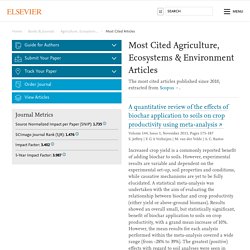
Jeffery | F. G A Verheijen | M. van der Velde | A. C. Bastos Increased crop yield is a commonly reported benefit of adding biochar to soils. The Oft-Forgotten Art of Growing Mulch. What a Pile of Mulch (Courtesy of Joe Hoover) Mulching: We know we’ve got to do.
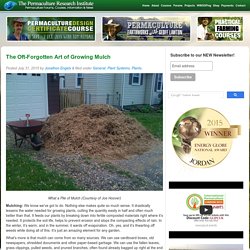
Nothing else makes quite so much sense. It drastically lessens the water needed for growing plants, cutting the quantity easily in half and often much better than that. It feeds our plants by breaking down into fertile composted materials right where it’s needed. It protects the soil life, helps to prevent erosion and stops the compacting effects of rain. What’s more is that mulch can come from so many sources. Hot Composting with the Berkeley Method - Kerr Center. Remineralize the EarthRemineralize the Earth. Hugh Lovel: Diagnosing Soil Potential & Pasture Health - the Silica Story from Acres USA. In this session consultant Hugh Lovel will discuss silica.
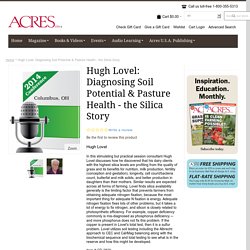
He’ll show, for example, that his dairy clients with the highest silica levels are profiting from the quality of grass and its benefits for nutrition, milk production, fertility (conception and gestation), longevity, cell count/bacteria count, butterfat and milk solids, and better production in daughters than their mothers. Similar results are expected across all forms of farming. Lovel finds silica availability generally is the limiting factor that prevents farmers from obtaining adequate nitrogen fixation because the most important thing for adequate N fixation is energy.
Adequate nitrogen fixation fixes lots of other problems, but it takes a lot of energy to fix nitrogen, and silicon is closely related to photosynthetic efficiency. Redworms vs Black Soldier Grubs - Which is better for vermi-composting? The Humanure Handbook: A Guide to Composting Human Manure by Joseph C. Jenkins. Green Your Head: backyard biochar tech. Josiah Hunt has been doing commericial biochar longer than just about anyone.
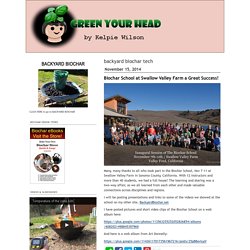
He is perhaps the finest example we have of small scale, low tech biochar entrepreneurship. Being in Hawaii helps - he has abundant feedstock, abundant need (poor tropical soils subject to leaching rainfall) and an educated public of permacultural farmers who get it. But despite the advantages of location, it was Josiah's genius that drove him to invent an economically sound biochar production method that allowed him to actually start a business. Not only that, his method is pretty clean, unlike traditional charcoal pits that smolder wood for many days and emit methane and carbon monoxide. In the open pit method, these gases are burned off so there is very little smoke. Backyard biochar kiln instructions. Make your own BioChar and Terra Preta. tBJ:all articles. Backyard_Biochar. Composting Coffee Grounds - Of Mice and Mountain Men Blog. I drink a lot of coffee; probably too much coffee, but that’s another issue.
As a result of my coffee habit we have a steady supply of coffee grounds to dispose of. Coffee beans are a plant, why not compost them along with the rest of my kitchen waste? And that’s what I do. Teaming with Microbes: A Gardener's Guide to the Soil Food Web by Jeff Lowenfels. Improving Your Soil - The Natural Way (GardenEzi Books) by Julie Lake. Improving Your Soil: A Practical Guide to Soil Management for the Serious Home Gardener by Keith Reid. Build Your Own Compost Tumbler - Farm and Garden.
Truth be told, our compost pile very rarely, if ever, gets turned. When it comes to the compost heap, my preferred method is to pile it up and let nature take its course, which it effectively does. Compost cures whether you turn the pile or not; it just happens at a slower pace when you leave it to nature alone. While this method of composting is easy on the back and takes little effort to maintain, it does take time for the process to complete — sometimes up to a year or more. Small and decentralized wastewater management systems - Ronald W. Crites, George Tchobanoglous. Treatment Wetlands, Second Edition - Robert H. Kadlec, Scott Wallace.
500 showers heated from one small compost pile: a how to tutorial. Using Constructed Wetlands for Removing Contaminants from Livestock Wastewater, A-5-98. 2021 Coffey Rd., Columbus, Ohio 43210 Kenneth D. Simeral Associate Professor The Ohio State University Introduction Environmentalists have referred to wetlands as nature's kidneys. Much interest has developed in recent years in using constructed wetlands to remove contaminants from water, whether it is effluent from municipal or private waste systems, industrial or agricultural wastewater, or acid mine drainage. In a practical, low-cost approach, this publication deals with the principles of creating surface flow wetlands for the removal of contaminants from wastewater generated by livestock production operations. To design and develop a wetland for effective wastewater treatment, it is necessary to understand the processes that occur in wetlands. (Handbook of Constructed Wetlands, Vol. 1) Livestock producers must consider both the advantages and limitations of such a system to decide if a constructed wetland is applicable to their operations.
Advantages. LIVING MACHINES: Clean, Green Waste-Water Recycling. Resembling something like a tropical forest, John Todd’s attractive solution to waste-water management uses plants to clean up water. Consisting of a series of ecosystems that work together to break down water contaminants, Todd’s approach offers a natural and eco-friendly alternative to costly traditional water treatment plants. The concept was recently awarded a Buckminster Fuller Award for its elegant application in cleaning up Appalachia’s water supply, and has been adopted and adapted by many eco-minded individuals around the country.
Converting sewer sludge to fresh water is no easy job; traditional treatment plants consume massive amounts of money, energy, and resources. John Todd’s innovative solutions for waste-water management re-envision the process as an eco-conscious endeavor, conserving water and reducing overall treatment costs with minimal sludge disposal, water purchases, sewer surcharges, and chemical use. Vermont Rest Area Uses Green Wastewater Treatment System - Vol. 63· No. 6 - Public Roads. By Molly Farrell, Liz Van der Hoven, and Tedann Olsen When the sewage treatment system failed at Vermont's busiest interstate highway rest area, "up from the ground came a bubblin'" something that was crude and smelly, but it wasn't oil.
State officials had a serious problem that had to be corrected quickly. They decided to install an innovative new system called the Living Machine. This system uses a series of tanks containing plants and other organisms to naturally clean wastewater. The welcome center on I-91 in Guilford, Vt., was built in 1966. Like most rest areas in Vermont, the Guilford center was built in an isolated area on poor soil. "We didn't want to impact communities with noise and pollution, so rest areas weren't usually built near towns," explained Dick Foster, director of the Vermont Information Center Division of the state's Department of Buildings and General Services. Plants for wastewater remediation. Aquatic Plants for wastewater purification. Using Plant-Based Biofilters to Purify Household Wastewater. Growing Away Wastewater. When an eastern Massachusetts homeowner planned to add two bedrooms to his house, he learned that he would have to upgrade his septic system—to the tune of $75,000 and a 5-foot-high mound system.
Today, a patch of evergreens, holly, hostas, and irises creates an inviting landscape where that mound would have been. Plant Roots Used to Treat Wastewater. Wastewater Biofiltration. Welcome to the Compost Power Network. UC Davis Biochar Database. The Wastewater Gardener – Preserving the Planet One Flush at a Time. The New Create an Oasis with Greywater: Choosing, Building, and Using Greywater Systems, Includes Branched Drains by Art Ludwig. Start by marking “The New Create an Oasis with Greywater: Choosing, Building, and Using Greywater Systems, Includes Branched Drains” as Want to Read: Liquid Gold: The Lore And Logic Of Using Urine To Grow Plants by Carol Steinfeld.
Construction of Holzmiete-Inspired Compost Toilet and Urinal System. By Paul Kean, Tiger Hill Permaculture. How to Make a Vermicomposting Flush Toilet. 7 Uncommon Items You Should Toss Into Your Compost Pile. Biochar! The verdict is in: it works. And you should do it. Living Soil and Plant Nutrition from Edible Perennial Gardening. Soil Food Web Course. 8 Brilliant Ways Sweden Recycles Its Garbage. Cathy's Crawly Composters, Canada - worms, nightcrawlers, products. The Complete Compost Gardening Guide: Banner Batches, Grow Heaps, Comforter Compost, and Other Amazing Techniques for Saving Time and Money, and Producing the Most Flavorful, Nutritious Vegetables Ever by Barbara Pleasant — Reviews, Discussion, Bookclubs,
01744 FarmCompost. Low-Tech Natural Nursery Strategies, biochar seeding mix. Vermicompost Womens self help micro business. OSCR Flow-through Vermicomposting system Plans and Site License [OSCR_1] - $50.00. : Vermicomposting: A Starter’s Guide for Teachers Excellent links & info at end of article. UMass Extension Cattle, Dairy, Livestock and Equine Program. On-farm Composting & Vermicomposting. Vermico workshop, seminars, equipment, Seminars and Workshops. Wormswork / Wormswork Business Plan. How To Start Vermicomposting - Vermicomposting Guide. The Small Part-Time Worm Business « Worm Farming Alliance. Vermicomp 1. How to Start a Vermicomposting Business. Vermicomposting-business-farms-excellent resource links!!! Vermiculture FarmersManual gm. Friend Earthworm - Table of Contents. Raising Earthworms to Feed the Flock.
A Worm Farm in Your Duck Coop! (Alaska) Worms Produce Another Kind of Gold for Farmers. Just another WordPress.com site. Two-long-worm-beds. Black-bins-compost. Vermiculture (worm farm) ideas on Pinterest. Vermiculture Revolution: The Technological Revival of Charles Darwin's Unheralded Soldiers of Mankind by Rajiv K. Sinha. Vermiculture Technology: Earthworms, Organic Wastes, and Environmental Management by Clive A. Edwards. SCP Clearinghouse - SCP Initiatives - On-Site Waste Management.
East Side Compost Pedallers. Earthworm Production — Ag Alternatives. Sample Worm Budget. Worm Composting on a larger scale w/ Earthway Experience. Worm Composting Biernbaum 23pgs Jan2013. Composting for small farms: Journey to Forever. Red Worm CompostingInterview with George Mingin – Kookaburra Worm Farms. Worm Windrow Method for High-Volume Vermicomposting. Large-Scale Worm Composting. Composting Information and Websites. Worm Composting on a Large Scale: How it Works. 3,000 pounds of worm droppings a mere drop in the bucket of what this team aims to do.
Vermicomposting. Red Worm Composting. Raising Worms La Crosse Wisconsin, WI. Greywater Action. Recycling Connections Corporation. The Earthworm Book: How to Raise and Use Earthworms for Your Farm and Garden by Jerry Minnich.